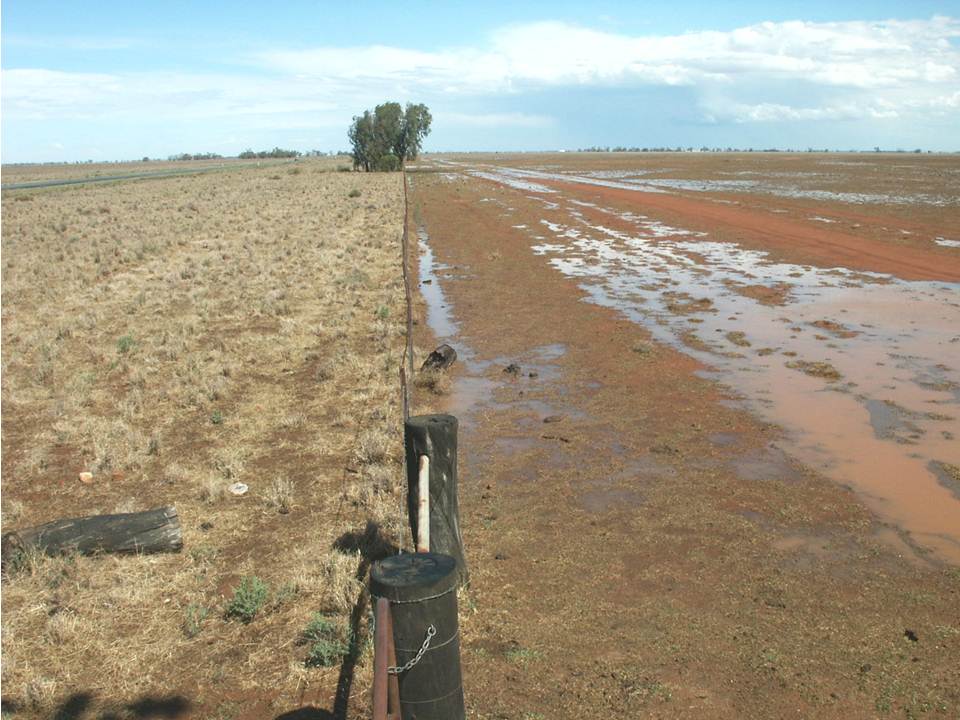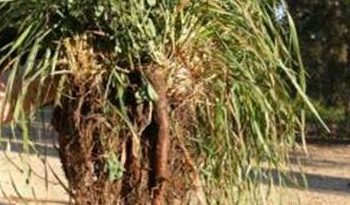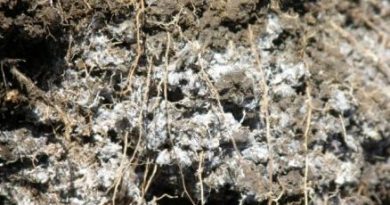Placing more emphasis on “carbon flows” for profitable farming
By Alan Lauder
Farmers, advisors and scientists have become too preoccupied with carbon stocks and measuring carbon and not paying enough attention to carbon flows. Just talking about carbon stocks is far too narrow. If you want to understand how your paddocks function, how to make more money, how to produce better greenhouse outcomes, how to reduce the impact of dry times, then all of these things will be clearer if you understand the concept of carbon flows.
The most important thing that happens in your paddocks is that carbon comes down from the atmosphere and flows through the paddock above and below ground, then returns to the atmosphere. In the process of doing this, carbon keeps your paddocks productive and healthy.
To understand the difference between the concept of carbon flows and carbon stocks, any carbon that is flowing through the paddock at the time of measurement, is recorded as a stock. Carbon flows are ongoing while carbon stocks are a measurement at one point in time. Carbon stocks at the time of measurement are called short term (labile), medium term and long term (non-labile).
Thinking carbon flows is to be aware of how much activity is occurring in your paddock. This is because products that follows carbon, energy, nutrients and water are central to production. The better you manage carbon flows, the more of these three you have access to.
Figure 1 shows carbon flows in action in the real world. Increasing carbon flows by planting saltbush have led to a long term degraded claypan turning into productive country.
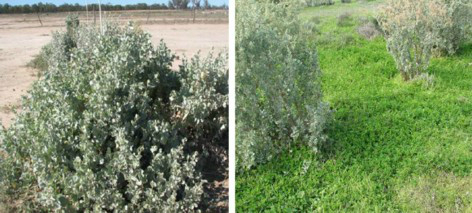
In the right hand image you can see carbon is now flowing in the area around the shrubs. In other words, the landscape is becoming more resilient. It is the carbon flows introduced by the planted saltbush, which has improved the soil. As the soil improved, grass was able to germinate and further expand the area that carbon is flowing through.
All this happened over a two year period at Yelarbon Qld, when rainfall was well below average. This highlights that with good management, dry times do not have to ruin the health of your landscape. The critical thing in dry times, is that you allow what rain does arrive, to produce some inflow of carbon. How well you let plants grow after rain determines how much carbon flows into your paddocks. This will be one of the themes of today’s talk.
After carbon flows started again, energy, nutrients and water all followed. Plants are now growing, which is introducing energy. The build up of organic matter is increasing nutrient supply. Looking at the prolific grass, water is obviously getting in.
Carbon management not explained
I spent 30 years running a grazing business in Western Queensland before leaving the land in 2000. Not once in that time was it ever explained to me that my success relied on how well I managed carbon in the paddocks. Discussing land management in terms of carbon management simply wasn’t part of extension.
It is ironic that carbon trading has introduced carbon into extension, when discussing carbon and what it does, should have always been central to discussing land management. It will probably take many years to see adequate attention paid to the “carbon flows” aspect of land management given past uptake of new approaches by institutions.
It is the ongoing flow of carbon that makes it possible for all the life on this planet to exist above and below ground. We are 18% carbon and I assume cows are similar. Grass is about 45% carbon when dried. All the life that lives in the soil and is responsible for keeping it well structured and fertile, also need carbon to build their little bodies, regardless of how small they are.
To help you understand the concept of carbon flows, carbon keeps moving out of its existing structure into new structures. The carbon atoms are always moving. Carbon is joined to just oxygen when it is carbon dioxide, then after photosynthesis it is in the more complicated carbohydrate structure in plants, then another form in cows and so on. The same process of carbon compound change is occurring in the soil – it keeps changing its structure as it keeps moving.
Each farmers day job is recycling carbon and in the process turning some of the carbon that is flowing through the paddock, into saleable carbon products, like grain, meat, fibre or hay. Selling cattle is harvesting carbon when it has entered the cattle part of the food chain.
A rural producer sells something that has lived and all life relies on the ongoing flow of carbon through the landscape. Nitrogen is just one thing that joins carbon in building life. You know this combination as the carbon:nitrogen ratio of life. When people get their head around the flows way of thinking, they quickly discover that the bulk of the carbon movement in the paddock, involves short term carbon compounds, not long term carbon compounds.
Above ground carbon important too
We are too focused on just soil carbon in extension. Extension does talk about ground cover, but we never talk about it in terms of carbon. Carbon flows only seem to be discussed as carbon when they are below ground. Institutional extension services focus on stocking rate, pasture utilisation rates and maintaining a minimum level of ground cover. This is 1980’s science as a government employee explained to me and is a disservice to farmers and export income. What sets the level of ground cover is how much carbon a particular form of management allows to come in after rain.
How much of the ground cover is then consumed is important, but it is the second decision you make. If you are just thinking stocking rate, then carbon flows are not part of your thinking. The only time we seem to think about carbon being above ground is in trees, but this is only because it is seen as long term carbon. Grass is short term carbon. This highlight the misplaced preoccupation with long term carbon when management changes are reflected mainly in short term carbon.
Figure 2 demonstrates the importance of short term carbon. In the figure the red section is the faster moving short term carbon and the black section is the very slow moving long term carbon.
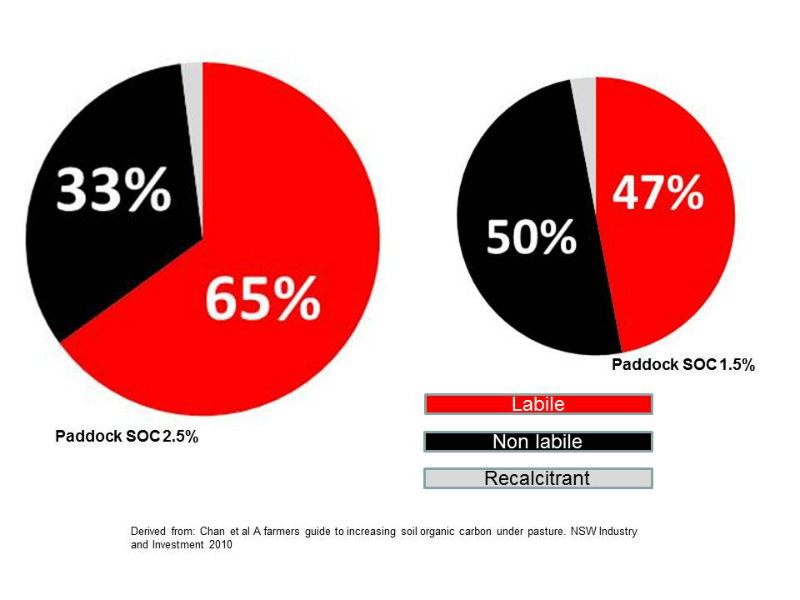
When soil organic carbon went from 1.5% to 2.5%, the change was driven by increases in the short term carbon called labile carbon. Look closely at the size of the black section, which is non labile carbon (long term carbon), and there is virtually no change. The percentage of long term carbon has changed on the left hand diagram, but this is because of the increase in the labile carbon (red section) has changed the total.
Two paddocks can have equal long term carbon stocks but it is the one that has the most carbon flowing through it that will have the highest level of production
It would be clearer for farmers if we discussed the different types of carbon in the landscape in terms of how quickly or slowly it moves. Some of the carbon moves very quickly through the paddock on its way back to the atmosphere. Some stays a bit longer and some of the carbon is moving very slowly. The faster moving carbon has a different role to the slower moving carbon. The energy is sitting in the red pool.
I am not suggesting that long term carbon is not important, because it is. The better soils have higher long term carbon levels, which is why you pay more money for them. What I am saying is that long term carbon is the carbon you have far less control over.
Figure 3 highlights that carbon flows have to be maintained because carbon keeps leaving the system. The arrows on the CO2 sections represent the loss of introduced carbon via consumption. Apart from fire oxidising carbon compounds, the oxidisation process relies on one life form consuming another. The diagram highlights that the outcome of photosynthesis is being reversed with every consumption event. You can see some of the original flow heading towards longer term carbon as it becomes less and less digestible.
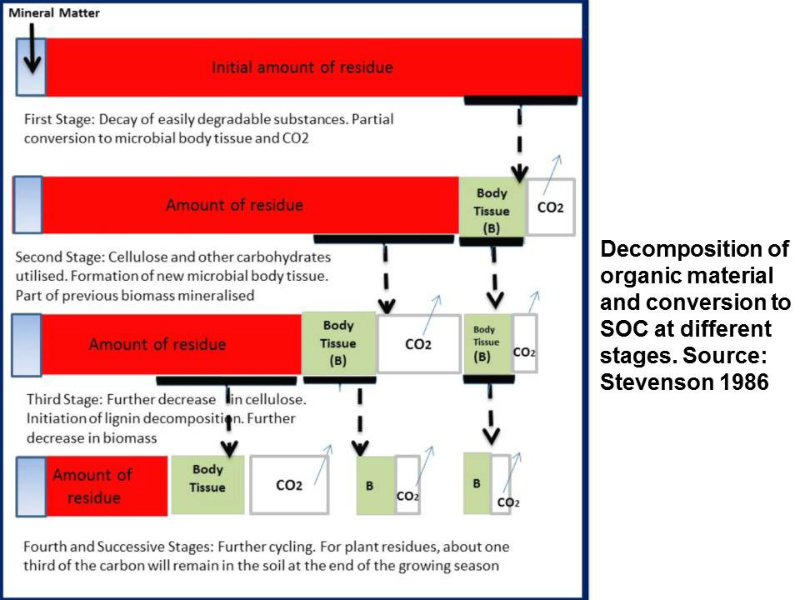
The carbon that flows in after rain initially goes into the fast moving carbon pool. Then some finds it way into the medium term pool and finally a little into the long term pool.
As a general comment, 75-80% of carbon that enters the soil will be gone within twelve months. The actual amount is determined by moisture levels and temperature. This highlights that if your management is not focused on carbon flows, then you run the risk of running short of this commodity.
You can be confident with the long term carbon measurement as it is measuring slow moving carbon. However with the faster moving carbon, you have to be careful of the circumstances under which you measure. It is very easy to catch a spike that is not representative.
Now coming back to the Carbon Farming Initiative (CFI). Any carbon that is in the stable long term pool has to start the journey as fast moving carbon, so soil carbon trading relies on the same management as making more money. You have to increase carbon flows. In fact this is the first example of the broader rule – “The greenhouse outcomes of the grazing industry are a reflection of economic efficiency”.
There is a reason why a paddock is more productive when carbon moves faster. It is simply because everything that is joined to carbon as it moves through the soil becomes available to plants sooner. Think energy and nutrients.
It is important to remember that the long term soil carbon is also flowing, but at a slower rate. For those interested in soil carbon trading, it is important to be aware that there is always a little bit flowing out of the long term carbon pool, that’s why all soils have a total carbon equilibrium. Carbon flows are going both ways, in and out.
Photosynthesis and energy storage
When photosynthesis occurs in plants when they grow after rain energy is stored. That is, the carbon in carbon dioxide, now forms more complex carbon bonds in carbohydrates. This is what scientists refer to as construction of energy.
How all life sources energy during consumption, is to break these complex bonds and release the energy. It is a case of reversing photosynthesis and converting the carbohydrates back to carbon dioxide. We breathe in oxygen to oxidise the carbon compounds and then breathe out carbon dioxide.
It is short term carbon and not long term carbon that is responsible for energy availability.
In Figure 1 there is a lot more energy residing in the soil with the higher short term carbon levels created by higher carbon flows in the recent past. Just as more nutrients are available.
Carbon flows different to the carbon cycle
Those in extension not thinking carbon flows the way I am presenting it, think that the discussion is simply along the lines of the typical carbon cycle diagram. The carbon cycle diagram is a one dimensional discussion explaining that carbon cycles, whereas the carbon flows discussion is about what carbon is achieving as it moves. It also focuses on how you can increase the flows of carbon. It explains why current carbon flows are influenced by all the feedback loops that come into play, depending on their previous management.
The resilience of your paddocks and their ability to respond to falls of rain, especially in dry periods, is determined by your previous management of carbon flows. Now for an example.
The right hand (RH) side of the fence in Figure 4 is a pasture paddock, not a farming paddock. Notice the water right to the fence line, then nothing on the surface over the fence.

The figure highlights what can happen, when animals are allowed to eat grass every time it tries to grow after rain and so greatly reduce carbon flows into the paddock.. Energy reserves are short term carbon. Resting after rain, to allow plants let energy in, is like keeping some charge in the battery.
To understand the failure on the right hand side of the fence, think of the soil as a construction site. What lives in the soil, keeps it well structured and fertile. If plants are not allowed to grow and feed carbon compounds to all the workers in the soil, then they die.
These images highlight that resilience relies on carbon flows. Think of resilience as having two components, plant resilience and soil resilience. Plant resilience fails first, then soil resilience declines. This highlights that your animal management affects the soil, by effecting plants first.
Figure 5 gets back to your day job, which is converting water molecules into carbon molecules. This is a practical example of the linkage between water use efficiency (WUE) and carbon flows.
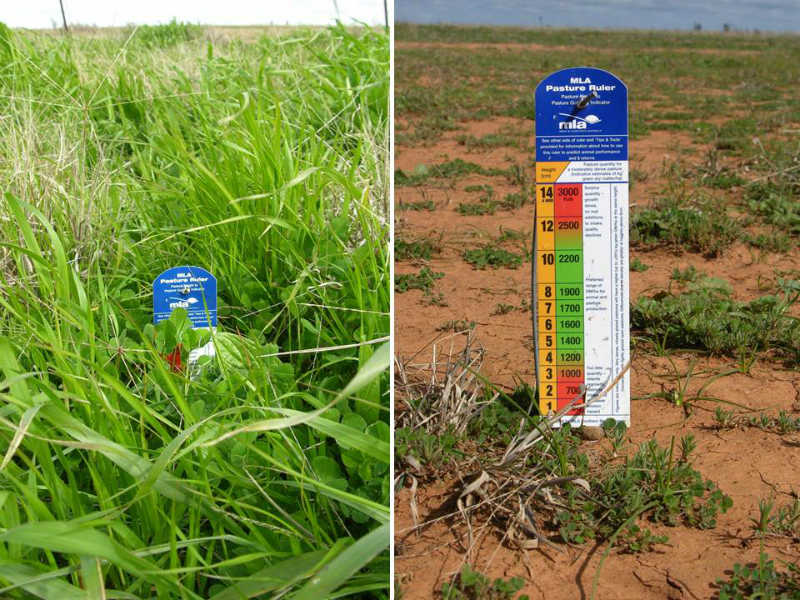
Figure 5 taken at the same spot as Figure 4 but during a high rainfall spring highlights that WUE relies on plant resilience and soil resilience. It also highlights that present carbon flows, rely on past carbon flows. Just as money makes money, so carbon makes carbon. Figure 5 explains what is behind disappointment when a paddock does not respond to rain very well.
Taking water use efficiency further, perennials bring down more carbon over time than annuals do. I wouldn’t like to be trading soil carbon on the RH side of the fence.
Short and long term resilience
The fast moving carbon supplies short term resilience. On the other hand, the slow moving carbon supplies resilience over time. It protects the long term survival of the system.
Management that increases fast moving carbon maintains larger root systems in plants which allows them to access more moisture and nutrients to grow, figure 6. This increases short term resilience.
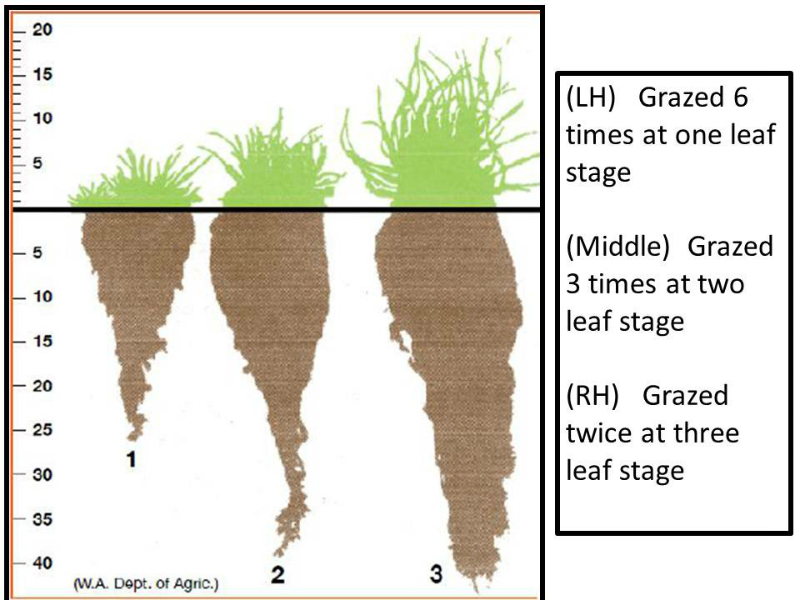
One way water gets into the soil is by running down beside roots. The level of water infiltration and to what depth, is influenced by the volume of roots and their depth. This is called the wick effect.
The fast moving carbon is part of energy reserves central to short term resilience. It is ground cover that increases water use efficiency by lifting wind and keeping the sun off the soil.
Root exudates are soluble carbon released into the soil by root tips and this supports soil microbes to make nutrients available to plants. Root exudates are some of the fastest moving carbon in the system.
Organic matter that supplies nutrients is short term carbon.
It is short term carbon that maintains soil biology responsible for creating macro-pores in the soil. These macro-pores will still be there after this fast moving carbon that facilitated their construction is back up in the atmosphere. Compaction occurs in a lot of soils when carbon flows fall.
The slow moving carbon (the long term carbon also called humus) is the other half of the resilience story. It supplies the long term resilience of your paddock. It greatly increases the nitrogen storage capacity of the soil. It provides better soil structure which provides spaces for water. It changes the pH of the soil and helps buffer against any toxic elements present. Because it is more stable, it is much less affected by management.
The Carbon Grazing principle
The size of carbon flows following rain is influenced by your management. The only way that carbon can move from the atmosphere to your paddock, is via photosynthesis. Given that it is moisture that promotes photosynthesis, then it is moisture that promotes the introduction of carbon. Nature has designed the system, so that water activates the storage of carbon in the landscape.
If you think about it logically, the bulk of the carbon enters the landscape in the short period following rain. This highlights the need, to focus management around this point in time. Letting animals eat plants when they are trying to grow after rain, reduces photosynthesis and in some cases, completely shuts it down.
There are some subtle realities that underpin the Carbon Grazing principle. Remember, it is a principle, and not a new land management system. It applies to all successful land management.
Because there is no pattern to when rain arrives, in other words, when carbon arrives, the message is that pasture rest is TIMING and not TIME. Basing resting decisions on a certain period of TIME, is no guarantee that carbon will arrive.
This is not an attack on cell grazing, where cells may be locked up for 120 days. Cell grazing implements the Carbon Grazing principle, because when rain arrives, the bulk of the cells do not have animals in them. Stating the obvious, continuous grazing never implements the Carbon Grazing phase of rest after rainfall.
Carbon Grazing is 4 – 6 weeks rest after rain. The period does not commence until the plants actually start growing. Also, it is important to not get caught up on the exact time, as factors like temperature influence the necessary time. Carbon Grazing is about maximising carbon flows. It is the window of opportunity too many people miss.
Figure 7,8 and 9 provide a summary of carbon flows principles. I am grateful to Patrick Francis, Moffitts Farm and the former editor of the Australian Farm Journal, for constructing the slides.
The three slides have the same format. They all rely on pictures and graphs to demonstrate the above ground and below ground outcomes, depending on how well carbon flows are managed.
Figure 7 demonstrates the outcome of applying the Carbon Grazing principle which maximises carbon flows each time it is applied.
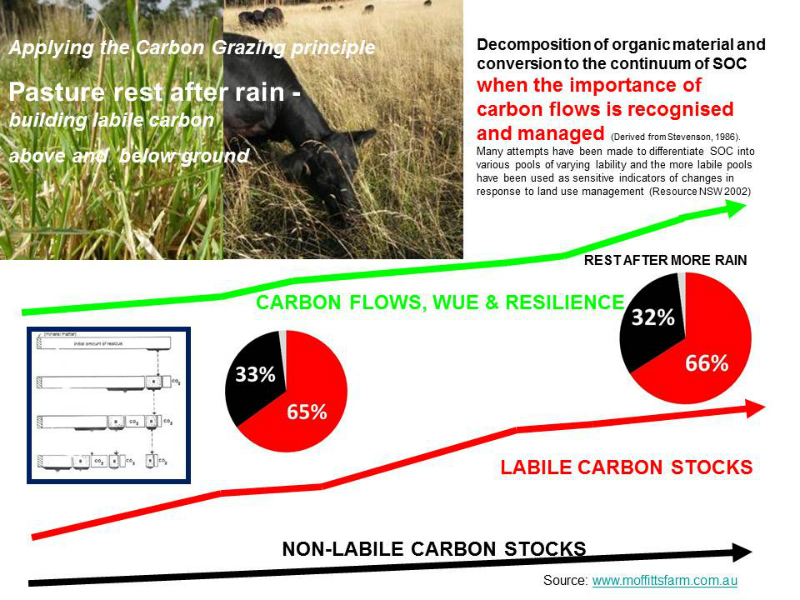
The first point to note in Figure 7 is the positive effect on ground cover as the photos show. The wording on the photos makes an important point that is often overlooked – ground cover is labile carbon. It was discussed earlier that the carbon flows debate extends past what happens in the soil to also include what happens above ground.
The pie chart is a reproduction of Figure 2 where Chan et al showed that the increase of soil organic carbon from 1.5% to 2.5% was just about solely due to the increase in labile carbon. This makes sense, because the increased carbon level would be a reflection of the increased amount of carbon flowing through the paddock.
The green graph line reflects carbon flows over time. You will notice that water use efficiency (WUE) and resilience parallels carbon flows. This is consistent with WUE relying on resilience and resilience relying on carbon flows. The green line charts your success in converting water molecules into carbon molecules – which is your day job.
There is a reason for the slight increase in labile carbon in the second pie chart. Current carbon flows rely on past carbon flows. It is the slightly increased short term resilience provided by the previous rest after rain that has influenced current carbon flows. In well managed paddocks only marginal changes are likely – it is more a case of maintaining what has already been achieved. It is poorly managed paddocks that supply the greatest opportunities for increases.
Putting management aside, the labile carbon stocks are set by seasonal conditions, and will fall in dry years. It is available water that influences carbon flows. Sometimes water does not arrive and sometimes your management is responsible for it escaping before being able to generate carbon flows.
The red and black graph lines represent labile carbon stocks and non-labile carbon stocks. The pie charts are representative of the direction these lines take.
Figure 8 shows set stocking. It represents a system that is operating at a lower carbon equilibrium above ground and below ground. The first thing you notice is that the pie graphs are smaller than the previous slide. The labile carbon is a much lower percentage of total soil carbon simply because carbon flows are smaller.
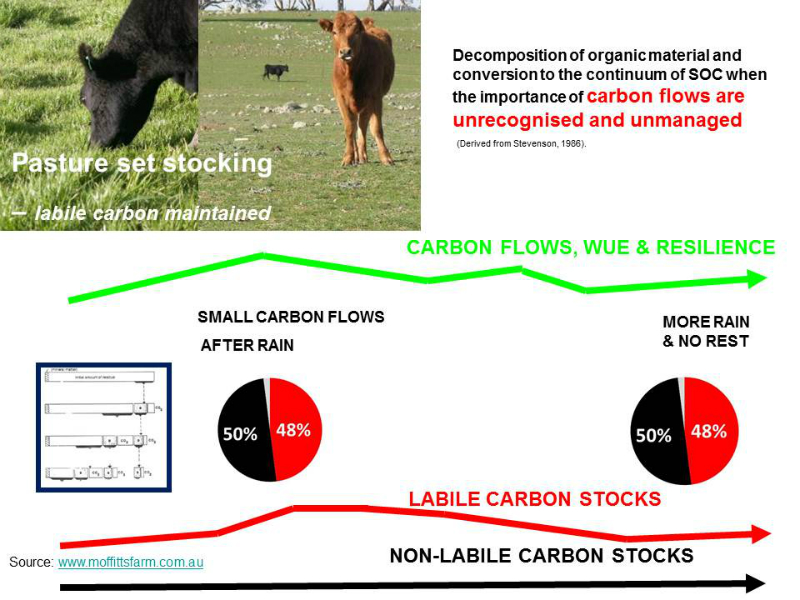
There is only a marginal increase in the green line after more rain, which highlights that carbon flows are not meeting their potential. Bare pastures have lower WUE. They do not respond as well to rain and revert to the non growth phase quicker. This is reflected in the lower percentage of labile carbon.
Figure 9 brings in the impact of a dry season or drought followed by heavy rain. It shows the risks with set stocking. The green line drops and is consistent with lower carbon flows in a dry season.
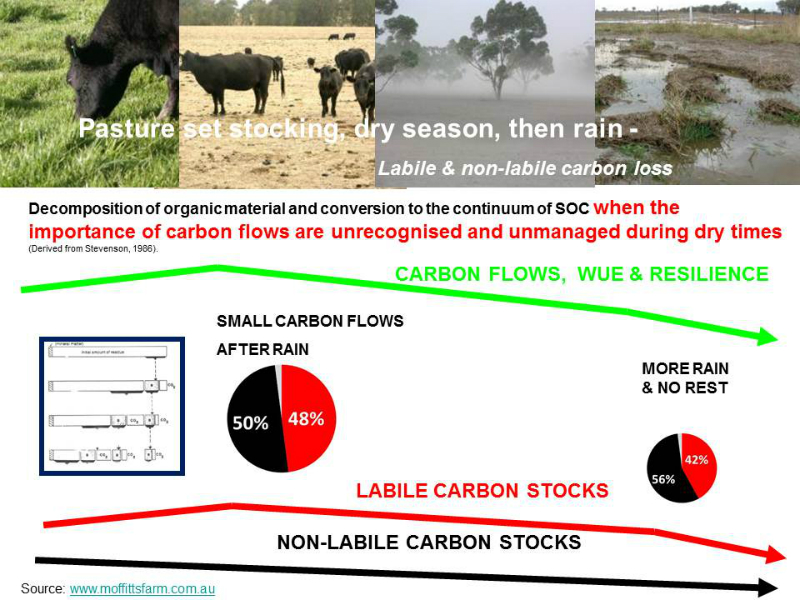
The telling message is the extent of the drop in the labile carbon and non labile carbon from wind erosion and soil erosion. This would not have occurred if the paddock had started with better ground cover and higher labile carbon levels in the soil.
The wind and water erosion that has occurred has removed labile and non labile carbon and this is reflected in the smaller second pie graph. Not only is the second pie graph smaller, but it also has a lower percentage of labile carbon. The assumption is that labile carbon resides more in the surface soil.
The future earning capacity of this paddock has reduced. With the removal of labile carbon there is a removal of stored energy and nutrients. With the removal of non labile carbon goes long term resilience.
Take home message
It is not until we pay more attention to the carbon flows aspect of carbon, that more attention will be paid in extension to promoting when the bulk of the carbon enters the paddock. This broader focus will lead to higher production.
I would like to finish by saying that the only time you can prepare for drought is when it rains. This is the only time you can increase your stock of above ground labile carbon.
Find out more:
For more details about Alan Lauder’s Carbon Grazing principles visit www.carbongrazing.com.au ; Patrick Francis has a series of articles on carbon flows and soil health on www.moffittsfarm.com.au . Source: This is an edited version of a presentation Alan Lauder gave at the Mareeba Rotary Field Days, May 2013. Rory and Kathy Frost saltpan reclamation – see article this web site in “Soil carbon types & carbon flows”.

